1446
By March, both the Bosnian and Serbian Armies had been wiped out, eliminating the Turks' shield in Europe.
June, Achaea was converted to Catholicism.
July, a white peace was signed with Georgia, removing a relatively minor power from the conflict.
September, half of Bosnia was occupied by the Venetians, adding it to the list of regions under effective allied occupation, Konya and Anatolia in Turkey being two other ones.
October, the last fortresses of Bosnia crumbled before Venetian arms, and this prompted their surrender and vassalisation to the Serenissima. This ended the Turkish influence in Bosnia.
December,
the Doge decided to further Venetian interests by adopting a National Trade Policy, increasing the efficiency of Venice's trade by 10%. This would greatly increase the amount of money harvested from trade - which made up 23% of Venice's income. Taxes made up 24% by contrast.
Later in December, Burgundy made peace with France, acquiring Cambray, Lyonnais and Auvergne.
1447
January, the effects of the National Trade Policy were easily seen, as Venice's montly trading income of 26 ducats jumped to 34 ducats, an increase of nearly 31%.
January 8, Kosovo was seized, ending Serbia's involvement in the war.
February, Doge Foscarini pulled some strings and had the vast Moroccan Empire made the target of a crusade, giving Portugal and Aragon bonuses for fighting it.
Later in February, the Kazakhs accepted a white peace after having their newly-arrived army humbled by a mixture of Papal, Aydin and Aragonese troops.
March, Edirne was occupied by Venice, driving the Turkish forces completely from Europe.
April, 5,000 Turkish patriots rose up in Angora, but being mostly infantry and going against General Casanova, they were doomed.
July, after the Papal-occupied province of Gabes was re-occupied by Tunisia, the Doge made peace with the Tunisians by signing a white peace.
September, an agricultural revolution prompted the Doge to work to maximise tax revenue from farmlands. This had the greatest effects in Judea, which had recently bloomed with farms as a result of investment from Italia.
Late September, Sinope and Sivas were occupied by Venetian forces. Only Erserum remained as a Turkish province free from foreign occupation. Ottoman territories in the Black Sea and the Caucasus, however, also remained free.
October, Foscarini won a typical landslide victory.
1448
January, missionaries were dispatched to convert all the provinces of the Near East and Egypt.
February, Georgia - the province, not the country - was occupied, leaving the Turks without a single province. The remainder of their country - Kaffa and Imereti - was under Aragonese occupation.
March, as Aragon made peace with the Turks and ended Serbia's vassalisation as a result, the heretic center of Alexandria was converted after mass conversion efforst began in January.
April, Serbia, now free from Turkish overlordship, was able to accept a separate peace with Venice. They paid 75 ducats, renounced claims on Zeta, and swore loyalty to Venice as their new overlord. The Turks no longer had sway over the Christian states of the Balkans.
April 11,
Nogai accepted an offer from Venice for a white peace. This left the Turks with no allies, no vassals, and no armies.
June, Imereti was occupied, and all Venetian-led forces converged on Kaffa.
August of 1448, the heretics of Morea were converted, purging Orthodoxy from Venice's Greek possessions sans Constantinople.
August 29, Kaffa, the former colony of Genoa, was occupied by a joint Papal-Venetian force. With that, the entire Ottoman Empire was under Venetian occupation.
The Sultan caved in immediately, signing a humiliating peace treaty on September 1, 1448. The treaty ceded Edirne, Bithynia, Karaman and Kaffa to Venice, while it also caused the Sultanate to relinquish it's claims on Larissa.
And so, Sultan Murad II's attempt to retake his "rightful" territory of Constantinople from Venice had ended in complete disaster. The vassal states of Bosnia and Serbia were severed from the Islamic sphere and re-attached to the Venetian, and the Turks lost all European territories besides Albania, which was torn between the Orthodoxists and Nationalists under Skanderbeg and the Islamists and pro-Turks under the local governors.
With the Turks crushed and their empire falling apart at the seams, Venice was secure. It was prosperous, had a healthy surplus, was steadily converting the heathens of the Near East, and had a network of vassals that gave it effective control of most of the Balkans, Greece, Italy and Turkey. Now the Doge had to focus his efforts to strengthening Venice diplomatically and commercially.
He did this by annexing Cephallonia in October, bringing all of Greece under solid Venetian rule. Now programs of mass conversion could be undertaken, making "Greek Orthodoxy" an oxymoron.
Later in October,
Foscarini persuaded the Pope to lift the excommunication that previous Papal controllers had placed upon Saxony, therefore securing better relations.
1449
January, Doge Foscarini passed reforms that further curbed serfdom in Venice. While some were concerned this might increase stability costs and make it harder to field massive armies, Foscarini mentioned that Venice already had a rather stable society thanks to great amounts of religious overtones and effective administration, and that the morale of Venice's people above all outpaced their number. Making people freer would also allow more freedom of thought and pursuit of opportunity, enhancing Venice's technological breakthroughs.
Mid-January,
Burgundy annexed Trier, adding one more province to it's bulky size between France and Germany.
Foscarini began to make plans to attack Hungary and press claims Venice had on Dalmatia for decades. Attacking Hungary directly would be foolish, as the Hungarians were aligned with Poland and thus would be able to turn into a steamroller.
It was instead decided to attack one of the minor German states, who's guarantees would prompt Hungary to join in and protect them.
So, Foscarini made overtures to the Savoyard government(Venice's second-richest vassal after the Papal States), resulting in an alliance with Venice. Offers also went out to Bosnia, Venice's third-richest vassal.
Serbia and Ferrara joined the alliance after Bosnia accepted, creating an alliance composed of Venice, the Pope, Savoy, Bosnia, Serbia and Aydin.
It was decided that rather than attack Hungary, an attack would be launched upon France, which was allied with Provence and Hungary. In a single war, Venice would be able to kick the Angevins out of Provence, humble France - which was still reeling from it's war with Burgundy - and claim the Dalmatian coast.
This was of course a very shocking move to the legislature, but Foscarini assured legislators, plutocrats and the people that Venice and her allies had a combined force of 41,000 troops, with the ability to readily raise more on the part of all parties. Hungary's forces were estimated at around 20,000 due to the force near the borders, and this force was divided amongst several provinces, while also focused on fighting the Turks. Provence possessed only 1,000 troops, inside Provence proper. France's troops remained unknown, but it was assumed they were reasonably small due to the fact Burgundy had damaged them so much.
By February, war was declared after claims were fabricated to the French border(on the behalf of Savoy).
The Underground voiced enormous protests against the war, saying they would no longer perform during it's duration.
The resulting alliance was Venice, the Papacy, Savoy, Ferrara, Aydin, Serbia and Bosnia against France, Hungary, Provence and Foix.
The Doge's strategy was to smash through the Hungarian Army, and then spread across their territory. The Pope would besiege Naples, allowing all remaining Italians to focus on defeating incoming French forces.
By March, most of the Hungarian Army had combined into one single unit moving across Bosnia, occupying the entire northern half of the country in a matter of days.
April, the Battle of Bosnia ended with an epic Venetian victory, thanks to the leadership of General Casanova. The Hungarian Army mainly went towards Croatia, though a small force retreated to Osijek. Casanova was ordered to use his forces to first destroy the small force in Osijek, and then attack the main Hungarian army. Without leadership, the Hungarians were sure to crumble.
June, an alliance offer from Castile was accepted, even if they were likely to cancel it the moment Venice went to war.
September, the main Hungarian Army was destroyed while Mamluk-sponsored Sunni zealots rose up in Gaza. Casanova was given orders to leave Hungary and move to Italy to repel the full-scale invasion the French had launched.
September 19, the Sunni zealots in Gaza were exterminated. Conversion efforts continued unhindered.
October, 13 regiments - 10 cavalry and 3 infantry - joined underneath General Casanova's leadership in Verona. He was ordered West to liberate Lombardia.
December, likely as a result of the mass reprisals carried out following the Sunni revolt, Gaza converted to Catholicism.
1450
January, Casanova's army was opposed by the full French army, equal in strength at 13 regiments, led by Pierre de Champmartin.
The battle was epic, ending in a Venetian victory.
February, Banat and Osijek were occupied by Venice.
March, Naples was occupied by the forces of the Pope, Aydin and Ferrara, before being turned over to Venice. This freed up five regiments - one of them cavalry - to move north and help in repelling the French invasion.
April, the Battle of Piedmont destroyed all of Foix's troops in Italy.
June, the Battle of Liguria turned the war in Venice's favor, with much of the French invasion force being wiped out. Casanova was taked with invading Provence and demolishing their military. Troops were also to be sent to Savoy to liberate it from French rule.
July, the Battle of Provence wiped out the entire Angevin army, and Provence was immediately occupied by Venice due to a lack of a French occupying force in the area.
September, Dalmatia was occupied, leaving Hungary's southern provinces under solid Venetian rule.
December, the Doge honored a call to arms from Castile, to fight against Morocco. This would give Venice income benefits for being on a crusade, even if Venice didn't actually fight them.
1451
January, Piedmont was liberated, allowing the Savoyards to once more have a role in the war.
February, Corfu was converted to Catholicism.
March, Aragon ended it's war with Morocco, taking Tlemcen and Mellila.
April,
Janina was converted, eliminating Orthodoxy from Cephallonia.
July, Savoie was liberated, ending France's occupation of the Savoyard Republic.
October, the aging Foscarini retained his position as Doge despite public concerns of if Venice could continue to support the strain of the war effort.
This was a wise move on the part of all electors, as the province of Dauphine fell to Venice days later.
1452
January, Languedoc was occupied by the combined might of Aydin and Venice. This left France's population in a panic, as they realised that the Venetians now were occupying their homeland.
March,
Diamentia in the Near East was converted to Catholicism.
April, Burgundy pressed claims to the French province of Vermandois on their border. The Doge prayed Burgundy would soon take advantage of France's current situation...
July, Tunisian Asyut was occupied by Venice, minimising their threat to the Republic, as they were allied to Morocco. Rousillon was captured shortly after.
September, the short war with Morocco ended, with Castile taking away a large bounty of ducats as well as the provinces of Constantine and Ifni.
More importantly, Burgundy attacked France, quickly rampaging through the north. Hungary dishonored it's alliance, while Castile guaranteed France in the aftermath.
In December, Burgundy pressed claims to Savoie. It was expecting the Emperor and Venice would eventually go to war.
1453
February, Transylvania fell to Venice. Hungary had been driven more or less to it's outskirts.
April, Hungary's capital was occupied by a large Italian force, without any Venetians in it.
April 28, 3,000 Hungarian soldiers were massacred in the northwest of Hungary. Altogether, France and Hungary both had 2,000 soldiers on active duty across their vast realms. Venice and it's allies - and later Burgundy - had worked to destroy two of the most potent countries in Europe.
June,
the last regiments of the Hungarian military were destroyed, leaving Franco-Hungarian forces with less than 1,000 troops total.
September,
the short Franco-Burgundian War ended, with Burgundy taking Caux, Champagne, and 10 ducats. The Burgundians were sneaky enough to leave the one province they had a core on out of the peace deal. The Burgundians also ended the vassalisation of Foix.
Accordingly, the government of Foix sent a peace offer, wanting to regain administration of their territory.
The Doge replied that Foix would retain it's independence, but would have Venetian oversight and protection. It was agreed that Foix would become a vassal of Venice.
October 5, Casanova's forces seized control of heavily-fortified Toulouse.
1454
February, Limousin and Armagnac fell to Venice. The French leadership knew it's time was limited.
March, Budjak, the last fortress of Hungary, fell to the combined forces of Aydin and Venice. The Hungarian King accordingly surrendered, turning large swaths of land over to the superior Venetian alliance.
The Hungarian phase of the Franco-Venetian War was officially over. Hungary was reduced to a landlocked country, losing it's control over all Croatian territories except Slavonia(which was now dominantly Magyar), and above all facing humiliation. Anarchy would follow the months after the war, as the Hungarian military was non-existent and local forces were both ineffective and corrupt, with the peasants themselves being very dissatisfied.
---
Now that France's Magyar pets had been put down, the Coalition's full efforts could be focused against France.
June, Delta was converted to Catholicism, reintroducing Christianity to the Nile Delta.
August, as a result of successive victories and the outright extermination of the French military, General Mose Casanova arrived at the outskirts of Paris. The French were doomed, and 13,000 soldiers crossing into France from Venice's allies was further proof of this.
1455
May, Vermandois was occupied. This left only Paris and Normandy under actual French administration. There were reports that the King had fled incognito to Normandy and was planning to board ships bound for friendly countries, mainly Castile, which guaranteed the continuation of the French royal line.
August 1, 1455, the city of Paris fell to the Venetians. Just like the fall of Constantinople, this sent shockwaves throughout Europe. The powerful French military was unable to defeat the Venetians and their allies, prompting Europe to rush into the arms of the Holy Roman Emperor, Philippe the Good of Burgundy. Philippe's roles as Duke of Burgundy and Holy Roman Emperor made him by far the most powerful monarch in Europe, and so it was believed that he had the best chance of defeating the Venetians.
But such speculation would have to wait until another time to be proven. The King of France capitulated, ceding Dauphine, Languedoc, Naples, and finally renouncing all claims to the Venetian vassal of Foix's territory.
The Kings of France and Hungary were humiliated thanks to the Franco-Venetian War of 1449-1455, with their armies wiped out, Venice's claims on Dalmatia realised, vassals gained, Hungary landlocked, and above all the transition of European leadership to Burgundy.
But of course, as soon as foreign troubles ended, domestic ones began. The merchants and those supporting Venice's role as a sea power raised hell on the issue of having vassals in landlocked and disconnected Foix, as well as the ownership of the provinces of Dauphine, Osijek and Banat.
The Doge said that Foix would remain firmly within Venetian hands, but that Dauphine would be ceded to Savoy, Banat to Hungary and Osijek to Bosnia. The legislative upstarts were pleased...
With the war over, Casanova left his victory parade in Paris to go to Savoy, to liberate the provinces under the control of heretics.
October, Venice lost control of the Curia, with England taking advantage of it's new powers to excommunicate the ruler of France.
October 14, Foscarini was re-elected Doge anew, against all odds.
November, the death of the Big Red Friendly Cardinal Clifford enabled Venice to become the Papal Controller anew.
December, a new Court theologian was appointed, helping to further conversion efforts in Judea and Edirne.
With that, 1455 ended. Venice had crippled two rivals, who were likely to be crushed by their neighbors in the coming years.
As usual, Foscarini had a lust for war. While eyeing the Roman Gem, he believed that his life was nearing it's end.
But he wanted to go down with glory. So, he planned to unify the Italian people under Venice's leadership, and he would do this by crushing the Aragonese and their Portuguese and Salzburger allies. Once destroyed, Venice would be unquestionable overlord of both the Western and Eastern Mediterranean, with the unification of Italy complete and with a sphere of influence in Germany.



 From what I know, I'd become very wealthy if I vassalised them all... it would also be a near-guarantee on becoming Emperor provided I kept good relations/became a monarchy.
From what I know, I'd become very wealthy if I vassalised them all... it would also be a near-guarantee on becoming Emperor provided I kept good relations/became a monarchy.




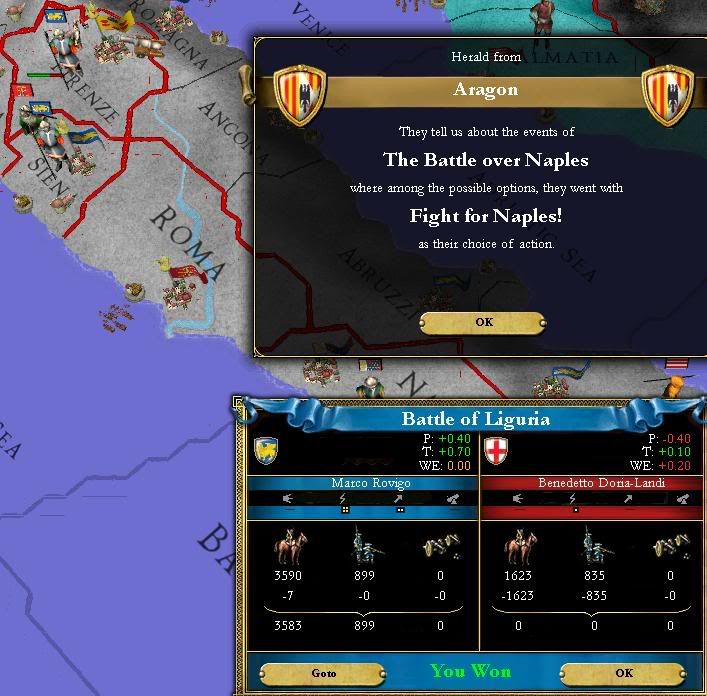




















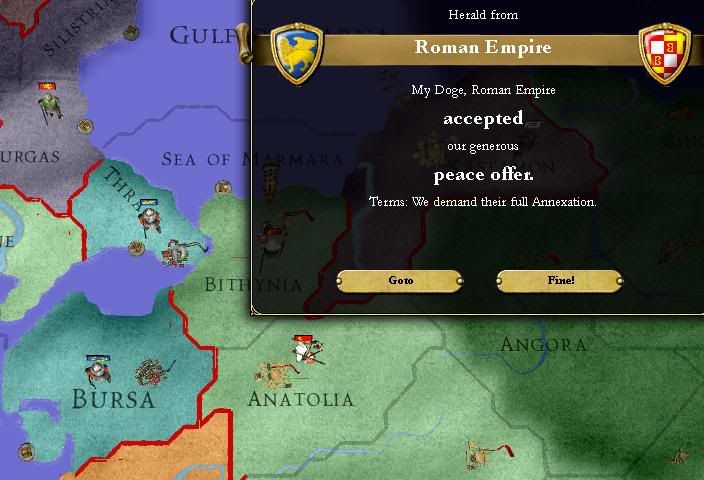


 Venice has had to fight much worse battles before.
Venice has had to fight much worse battles before. 




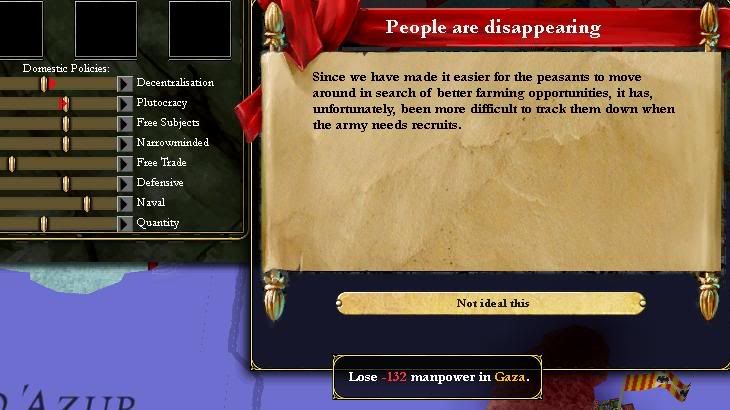




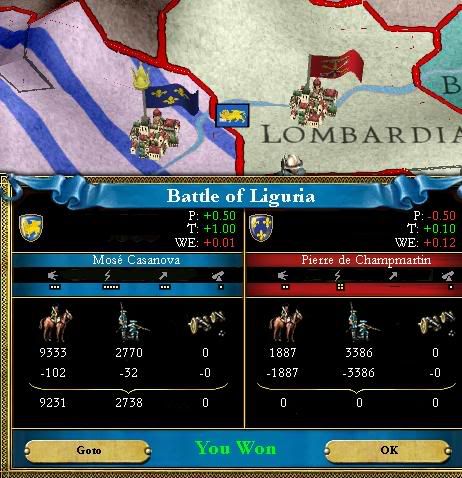
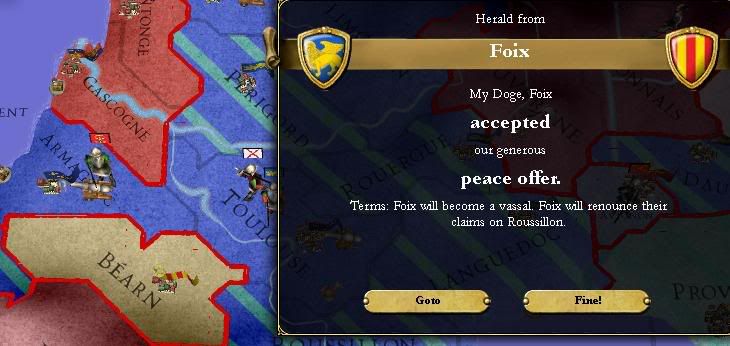




 (The Curia bonus of 20% cheaper stability, the prestige bonus of 30+% cheaper stability, and the administrative rank of Foscarini could be major factors here as well; also, the fact most of my provinces are Catholic probably helps)
(The Curia bonus of 20% cheaper stability, the prestige bonus of 30+% cheaper stability, and the administrative rank of Foscarini could be major factors here as well; also, the fact most of my provinces are Catholic probably helps)